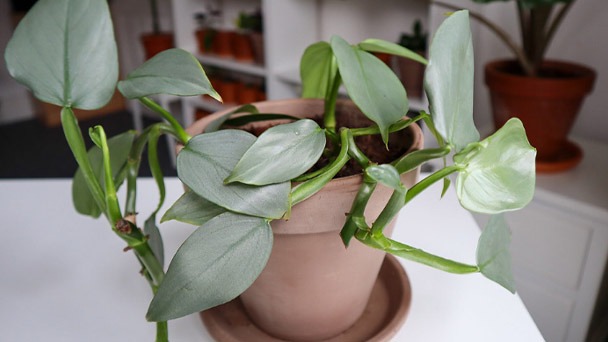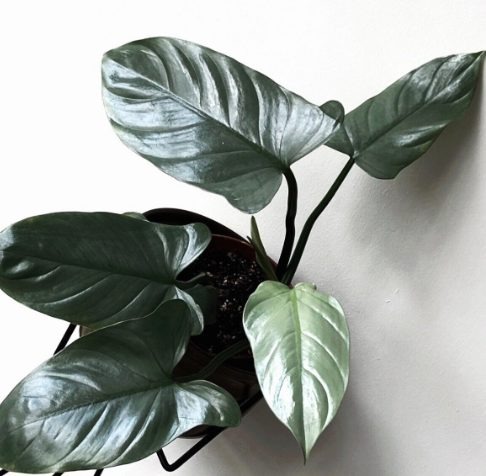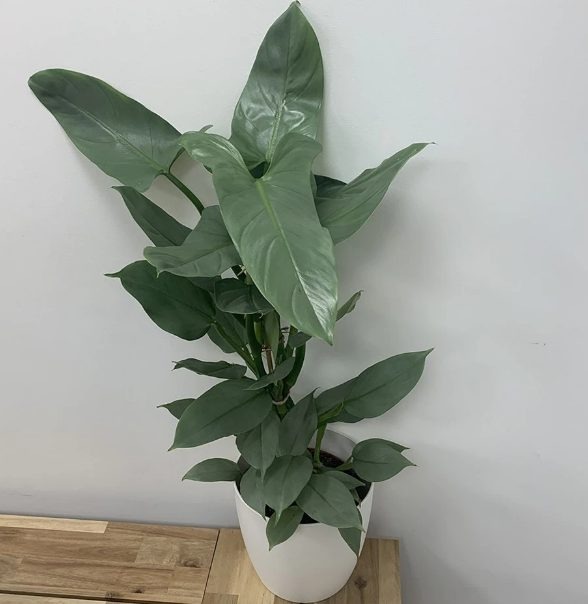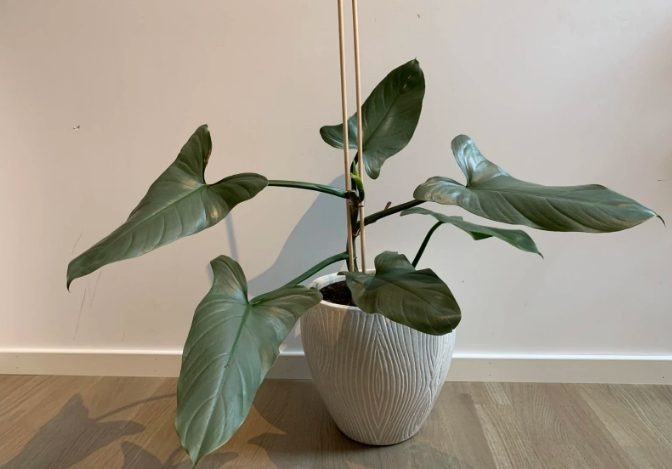How to Care for Philodendron Silver Sword - What You Should Know
Written by Ivy
Jan 30 2023

Need advice on how to take care of a Philodendron Silver Sword? One of my favorite features of the lovely and somewhat uncommon philodendron hastatum is the silver sheen on the leaves. Both obtaining it and spreading it are simple processes.
With our in-depth care guide, you can learn more about this lovely low-maintenance variety.
An Overview of the Philodendron Silver Sword

The Philodendron Hastatum, also known as the Philodendron Silver Sword, is a lovely vining plant with lance-shaped, bluish-silver leaves. Younger Philodendron Hastatum foliage has a more pronounced silver color and sword shape; as the plant matures, it develops a greener color and a more arrowhead-like shape.
The growth cycle of Philodendron Silver Swords is peculiar. These Philodendrons are originally terrestrial plants. They lose their hemiepiphytic characteristics as they develop and turn fully into aerial plants. The Silver Sword Philodendron is an Aroid plant with characteristics that are typical of this plant family.
The growth of silver swords is quick. These plants grow more rapidly and produce larger leaves when given a stable structure to climb. Because of its trailing nature, a hanging Philodendron Silver Sword is equally lovely. Simply hang your Philodendrons in baskets to fully appreciate their striking foliage. A Silver Sword Philodendron can grow up to 1m tall under ideal circumstances.
How Do You Take Care of a Philodendron Silver Sword?
This philodendron hastatum is nicknamed the "silver sword" because of its distinct glossy leaves that come to a sharp point, similar to a sword. Because of its silvery, metallic-shining leaves, this plant is the ideal addition to your home decor. This philodendron is a climbing vine with a thick stem, so it can grow up a simple stake or climb across a trellis as it matures
The silver sword philodendron can thrive in almost any indoor environment, requires little maintenance, and is relatively easy to care for. Like most indoor plants, it prefers bright, indirect sun and adheres to conventional watering guidelines. It is also not particularly vulnerable to pests. Your plant will look fuller and more vibrant with the right lighting, perfectly filling your indoor space.
Light
Since they are native to the rainforest, these Philodendron Silver Swords do not like direct sunlight very much. The best location for it is next to a window where no direct sunlight will touch the unusual leaves because they burn quickly. However, make sure the plant receives an adequate amount of direct, bright light.
Philodendron Silver Sword is not getting enough light if the stems start to look long and leggy and the leaves start to spread apart. The plant lengthens as it searches for more light, which causes this to occur. Given that its thick stems climb up poles and trellises, it may appear a little lanky, but if the plant appears healthy, it is probably not.
Water
During the spring and summer when your Philodendron Silver Sword is growing, water it two to three times per week. To prevent the plant from drying out in the winter, cut back to once a week. Depending on the climate and air quality in your home, this might be slightly less frequently than once a week. In the winter, I usually water my plants once every 10 days or so.
Philodendron Silver Sword is vulnerable to root rot, so make sure the top two inches of soil are dry before watering. When you don't water it enough, the leaves will droop, but once you establish a sufficient watering schedule, they should quickly recover. The leaves should only occasionally be wiped clean. Avoid watering the leaves.
Soil
Care for Philodendron Silver Sword must take into consideration the soil. Like the majority of other philodendrons, this plant thrives in loose, moist, but not excessively wet soil that drains well. This plant prefers soil with high levels of organic matter because it is a climber. The silver sword climbs on other plants in the wild, stealing their nutrients (organic matter).
Meeting the plant's nutritional and water needs depends in large part on the soil. To increase the proportion of organic matter, you can use a standard potting mix and add compost or well-composted manure. Add coco coir or fine moss, along with perlite, to the mixture to improve drainage.
Temperature & Humidity
Philodendron Silver Sword should be obvious that the philodendron hastatum prefers warmer temperatures because it is a native of the rainforests of Brazil and even some regions of Australia. The range of 65 and 80 degrees Fahrenheit is ideal for growing a silver sword. The plant will suffer and possibly die if exposed to the cold for an extended period of time because it is not tolerant of colder temperatures or frost.
It shouldn't be difficult to maintain a comfortable temperature if you're growing it indoors; just keep it away from radiators, vents, and drafts. My plant, I've discovered, is very tolerant of all typical household temperatures.
In addition to being warm, the rainforest is also very humid. It is necessary to artificially raise the humidity levels in your home if you want your Philodendron Silver Sword to truly flourish and for its leaves to appear as metallic and beautiful as possible. The plant can be kept in the bathroom, put next to other plants, placed on a pebble tray filled with water, misted frequently, or used with a humidifier, among other common methods.
Since Philodendron Silver Sword is enclosed and has a greenhouse cabinet from Ikea, I like to keep mine there. Even without a humidifier, the ambient moisture from the plants tends to keep things a little bit more humid. It's important to keep an eye out for yellow and droopy leaves in the winter because this is a sign that the plant needs more moisture. This is because the air becomes extremely dry during this time.
Fertilising
In the same way that taking supplements is not always necessary for humans, fertilizing Philodendron Silver Sword is. That is, until you begin to experience a deficiency and find that you are physically weaker.
Generally speaking, it is advised to fertilize your Philodendron Silver Sword every month from spring through summer. Your indoor plant is growing during these months. During these seasons, giving your Philodendron a nutritional boost will be very beneficial.
Pruning
To regulate a Philodendron Silver Sword's size and appearance, prune it. Remove any sick or brown leaves as well, as these eat up vital nutrients meant for the plant's healthier parts.
Repot
When it comes to potting, the most important thing is to buy a Philodendron Silver Sword pot with drainage holes to keep the soil from getting too wet and soggy. You just need to take care of this issue, and you're good to go.
Additionally, it has been discovered that Hastatums prefer round pots.
Additionally, a hanging basket is a suitable container for your silver sword.

Silver Sword Philodendron Propagation
The best way to multiply your Philodendron Silver Sword is through stem cuttings. Trim the leaves from a healthy, multi-node stem after which two to three of the nodes remain bare. The stem cutting can either be rooted in water or planted in moist, rich soil.
Covering Philodendron Silver Sword with a plastic bag will keep it very humid, and if the cutting is in soil, gentle watering every three days is necessary. Small roots and leaves will start to sprout after about six weeks. It can only be watered once a week at this point, and fertilizer can be added to encourage faster growth.
If you choose to propagate Philodendron Silver Sword in water, you can safely move it to a new pot once roots start to sprout after six to eight weeks. Remember that these are water roots, so when you transplant it to soil and it begins to form soil roots, there may be some shock. But it ought to revive once more.
Step 1. Pick a Healthy Philodendron Hastatum Plant
Selecting a healthy base plant is the first step in Philodendron Silver Sword propagation. Healthier cuttings are produced by well-fed, disease-free Philodendrons. Your new plant will benefit from stronger foliage and a strong root system as a result.
Philodendrons with sick stems or leaves should not be used as base plants because they are more susceptible to disease and pest infestation.
Step 2. Locate Where the Nodes Are
Locating the nodes is the next step in the propagation process. The nodes, which are the brown bumps on a Philodendron's stem, may eventually turn into roots.
To ensure successful propagation of your Philodendron Silver Sword cutting, choose a stem with a few nodes near the end of the stem where you will make the cut.
Step 3. Cut below the Node
Cut below the Philodendron Silver Sword node with a single swift motion using clean, sharp scissors. To keep your plant from suffering, avoid making multiple cuts.
Step 4. Place Your Stem Cutting in Water
When you've successfully created your cuttings, put Philodendron Silver Sword in a jar with fresh water. To avoid the growth of bacteria, make sure to periodically replace the water. Give the roots time to spread out; this typically takes a few weeks or so.
Step 5. Transfer the Stem Cutting to a Planting Site
Transfer the cuttings to a pot or garden area once the roots are a few centimeters long, then watch your plants flourish!
Is Philodendron Silver Sword Rare
Yes, it is fairly uncommon. I say this because, despite visiting numerous plant nurseries, I had never seen it in person. When it does reach the market, I believe it is quickly snapped up. Like my friend did for all of us when she saw them at the grocery store! I adore good finds at the grocery store.
Brazil's Amazonian rainforest is where the silver sword first appeared. Therefore, when taking care of it, remember that it is from a tropical region. Although it is a prolific grower in Rio de Janeiro, deforestation has unfortunately forced it onto the list of endangered plant species.
Sadly, this plant is now only used as a houseplant for decoration. Only once a philodendron hastatum reaches maturity, which takes about ten years, do its lovely small white flowers begin to bloom.
Why is My Silver Sword Yellow?
Yellowing leaves of Philodendron Silver Sword can indicate a variety of things. The first thing to look for is sunlight if the leaves of a silver sword philodendron start to yellow. The leaves may turn yellow if it receives too much sunlight. On the other hand, too little light can cause brown tips and yellowing leaves.
After lighting, the second thing you should look for is yellow or droopy leaves, which may indicate that the plant needs more humidity. Remember that a few yellowing leaves are normal, but if many do so at once, there may be a problem.
Common Problems With the Silver Sword Philodendron
The Philodendron Silver Sword has some drawbacks, just like any other plant.
Philodendron Hastatum Plant Pests
It is quite resilient to diseases and pests, however, in some environments that do not suit it, the Silver Sword can be attacked by spider mites and mealybugs.
Mealybugs can be removed using cotton balls dipped in rubbing alcohol.
Pests can be kept at bay by giving the plant regular waterings and applying insecticidal soap.
Red spider mites are a small species of pest that frequently prey on Hastatums. They are a difficult pest to spot but are widespread worldwide.
The development of tiny cobwebs on the leaves is one sign you can watch out for.
Another type of pests that commonly attack houseplants are thrips, also tiny insects that "travel" together, in groups, and are attracted to lighter colored leaves so they may give you a nip if you are wearing light clothing.
Discoloration of Foliage
The discoloration of foliage is a subject that needs to be covered in this guide as well.
According to Clemson University browning or yellow leaves may indicate too much or overwatering too much sunlight, and a pot is oversaturated by fertilizer.
Always put on your gardening gloves before handling the Philodendron Silver Sword because the Hastatums are poisonous and should be kept out of the reach of children and animals.
Conclusion
Use well-draining soil with peat and perlite for the Philodendron Silver Sword's maintenance. Let the top 1-2" of soil (2.5-5cm) dry out between watering. It should be between 65 and 80 degrees Fahrenheit (18 and 27 degrees Celsius). More than 50% humidity is required. Use a balanced fertilizer once a month during the growing season.

Frequently Asked Questions About Philodendron Silver Sword Care
How Big Does a Philodendron Silver Sword Get?
If it is normal-sized, it can grow up to 2 meters tall, and some can even exceed that and reach 3 meters.
How Often Do I Need to Water Philodendron Silver Sword?
If you see that the top 2 or 3 inches of soil are dry, stop thinking about it and water your friend
When is the Time to Re-pot?
Simply switch to a larger pot when you notice that the plant's roots are growing too large and strong for the current one.
Is Philodendron Silver Sword Poisonous?
Yes, just like any aroid, Philodendron species contain calcium oxalate crystals that will irritate your pets if they nibble on your plant.
Are Philodendron Silver Sword Plants Fast Growers?
These plants can develop relatively quickly depending on the growing environment, especially if there is enough warmth, moisture, and light.
Does Philodendron Silver Sword Flower?
It does indeed feature the typical aroid flowers. However, flowering rarely occurs indoors. If you grow this plant in a greenhouse, with a growing support, or outside, you are much more likely to see flowering.
Latest Updated
- How to Care for Philodendron Silver Sword - What You Should Know
- How To Propagate Peperomia Obtusifolia - Pruning & Propagation
- How To Prune A Red Tip Photinia - Plant Pruning Tips
- Diseases Red Tip Photinia - Causes & How to Save
- Photinia Plant: Grow & Care for Photinia Tree
- How Long Does Your Wood Fence Last - How to Maintain
- Can Vinyl Fence Be Painted - How to Paint it Simply
- How Much Does an Electric Pet Fence Cost - Is It Worth It?
- Woven vs Nonwoven Geotextile Fabric - Differences & How to Choose
- How to Grow & Care for Lilac Vine (Hardenbergia Violacea)
Popular Articles
- Winter maintenance of Antirrhinum Majus
- How to Grow Terminalia Mantaly Tree
- How to Grow and Care for Crossostephium Chinense
- How to grow Antirrhinum Majus in spring
- Peristeria Elata (Dove Orchid) Profile: Info & Care Guide
- Underwatered Snake Plant (Sansevieria Trifasciata) - Signs And How To Fix
- How to Care for Brazilian Jasmine Plant (Mandevilla Sanderi)
- How to Grow & Care for Graptopetalum Purple Delight in Summer
- Rosa Chinensis (China Rose): Plant Growing & Care Tips
- How to Care for Baby Sun Rose (Aptenia Cordifolia)